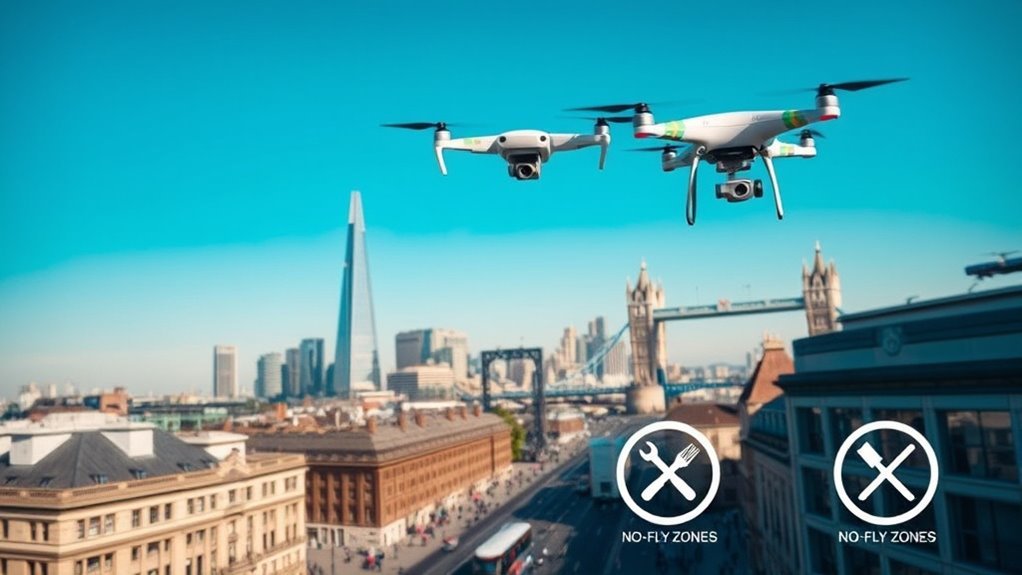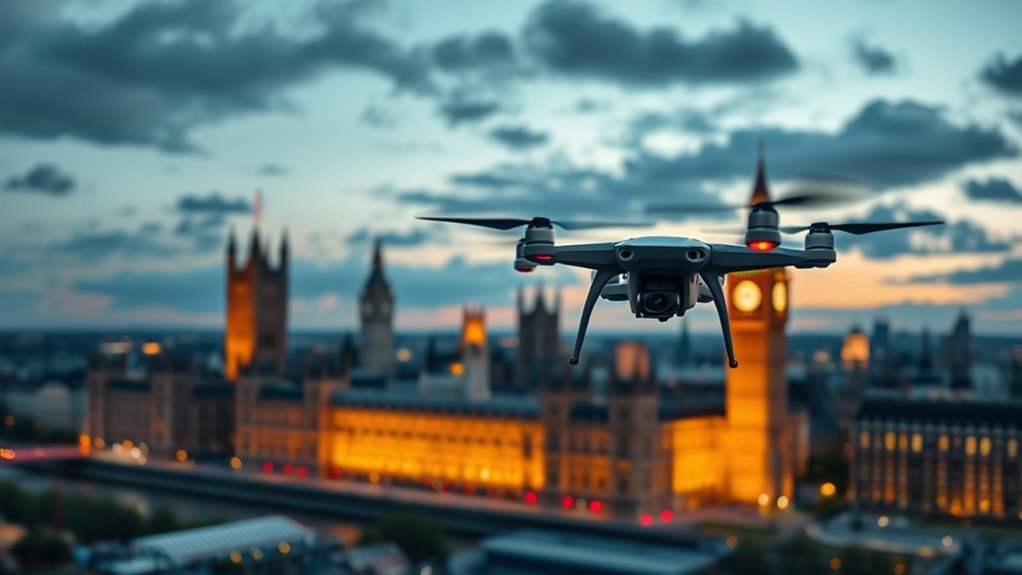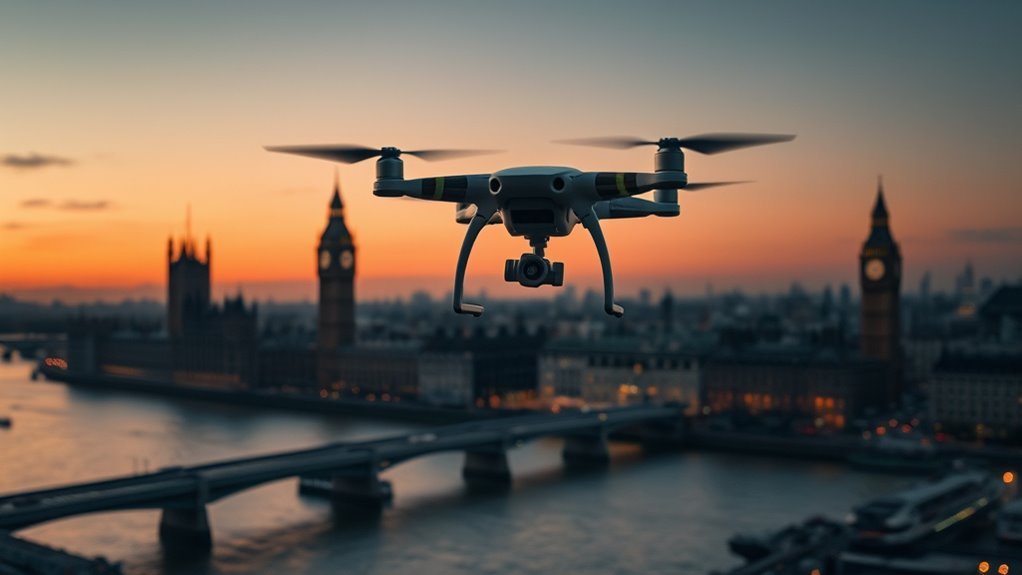To fly drones in London in 2024, you must follow key laws: register your drone to guarantee compliance, understand the Drone Code, and avoid no-fly zones like airports and central areas. Abide by height limits of 400 feet and maintain proper distance from people. Always consider privacy laws and secure any data you collect. Insuring your drone is advisable and be aware of penalties for non-compliance. Learn more about these regulations and how they impact your drone operation.
Drone Registration Requirements

In 2024, you’ll need to adhere to specific drone registration requirements if you’re planning to fly in London. The UK Civil Aviation Authority mandates that all drone operators register their devices, guaranteeing compliance with safety and legal standards. You’ll be required to provide user identification during this process, which helps maintain accountability and traceability in the skies. Registration not only grants you the freedom to fly but also protects your rights as a user by delineating acceptable practices. Remember, failure to register can result in hefty fines and restrictions, limiting your ability to enjoy aerial exploration. Embrace this responsibility to guarantee a safe and liberated experience while maneuvering London’s vibrant airspace.
Understanding the Drone Code

When operating a drone, it’s essential to be aware of the basic flight restrictions set forth in the Drone Code. These guidelines not only guarantee safety but also address privacy considerations that protect individuals’ rights. Understanding these rules helps you navigate the complexities of drone usage in London effectively.
Basic Flight Restrictions
Understanding the Drone Code is essential for anyone looking to fly a drone in London. You must be aware of the various flight zones, which dictate where you can and can’t operate your drone. Flying in restricted areas, such as near airports or crowded public spaces, is prohibited to guarantee drone safety for both you and others. Always maintain a visual line of sight with your drone and avoid flying above 400 feet. Additionally, pay attention to no-fly zones, which may be designated for safety reasons. Ignoring these basic flight restrictions can result in severe penalties, so familiarize yourself with the rules to enjoy the freedom of flying while guaranteeing safety for everyone involved.
Privacy Considerations
Operating a drone in London requires not only adherence to flight restrictions but also a keen awareness of privacy considerations. Understanding the potential surveillance impact of your drone can greatly influence public perception. Here are three key points to keep in mind:
- Respect personal privacy: Always avoid flying over private properties without consent to prevent intrusions.
- Be transparent: If you’re using your drone for commercial purposes, inform those who may be affected by your activities.
- Stay updated on laws: Familiarize yourself with local regulations regarding drone surveillance to avoid legal issues.
No-Fly Zones in London

Although flying a drone can be an exciting endeavor, it’s important to be aware of the no-fly zones in London, as they greatly impact where you can operate your aircraft. These restricted areas are essential for ensuring drone safety and preventing potential accidents. Familiarizing yourself with these zones will help you navigate your flying experience more effectively.
| No-Fly Zone | Location |
|---|---|
| Airports | Heathrow, Gatwick |
| Military Bases | Northolt, Aldershot |
| Urban Areas | Central London |
| Parks & Gardens | Hyde Park, Regent’s Park |
| Events | Major public gatherings |
Respecting these no-fly zones is crucial for responsible flying and maintaining your freedom to enjoy the skies.
Height and Distance Regulations
When operating drones in London, you need to be aware of specific height and distance regulations. For instance, there’s a maximum flight altitude that you must adhere to, as well as horizontal distance requirements from people and structures. Understanding these rules is essential to guarantee compliance and maintain safety in the airspace.
Maximum Flight Altitude
In London, drone operators must adhere to strict height and distance regulations to guarantee safety and compliance with the law. Understanding the maximum altitude is essential for maintaining flight safety while enjoying your freedom to fly. Here are key points to remember:
- Maximum Altitude: Drones can fly up to 120 meters (400 feet) above ground level.
- Airspace Restrictions: Always check for controlled airspace, where lower altitudes may apply.
- Emergency Protocols: If you encounter emergencies, you may need to descend below the maximum altitude quickly.
Horizontal Distance Requirements
After understanding the maximum altitude restrictions, it’s important to also consider the horizontal distance requirements that govern drone operations in London. You’ll need to comply with the horizontal distance guidelines, which stipulate that drones must maintain a minimum separation from people, structures, and vehicles. Typically, this distance is set at 50 meters horizontally from uninvolved persons and 150 meters from crowds. Adhering to these minimum separation requirements not only enhances safety but also guarantees that you enjoy the freedom to fly without infringing on others’ rights. Staying informed about these regulations will help you navigate London’s airspace responsibly, allowing you to maximize your flying experience while minimizing risks and legal complications.
Privacy and Data Protection Laws
Although drone technology offers exciting opportunities for innovation, it also raises significant concerns regarding privacy and data protection. When flying drones in London, you need to be aware of how your activities can impact personal privacy and compliance with laws governing data collection. Here are three key considerations:
- Informed Consent: Always obtain permission from individuals before capturing their images or data.
- Data Minimization: Limit the data you collect to what’s necessary for your specific purpose, ensuring compliance with the General Data Protection Regulation (GDPR).
- Secure Data Handling: Implement measures to protect any data you collect from unauthorized access or breaches.
Insurance and Liability Considerations
Steering through the world of drone operation in London requires a solid understanding of insurance and liability considerations to protect yourself and your assets. You’ll want to explore various insurance types, including liability coverage, which is vital for safeguarding against potential damages or injuries caused by your drone. Public liability insurance is often recommended, as it can cover claims made by third parties. Additionally, consider hull insurance to cover your drone against theft or damage. Understanding these insurance types not only guarantees compliance but also provides peace of mind. It’s essential to assess your flying habits and the environment you operate in to determine the right level of coverage for your needs. Don’t fly without it!
Penalties for Non-Compliance
Failing to adhere to drone regulations in London can lead to significant penalties, which can vary depending on the severity of the offense. Understanding these legal consequences is essential for maintaining your freedom to fly. Here are some key enforcement measures you should be aware of:
- Fines: Violating drone laws can result in fines ranging from hundreds to thousands of pounds, depending on the infraction.
- Confiscation: Authorities may confiscate your drone if you’re found operating it illegally.
- Criminal Charges: Serious violations can lead to criminal charges, which may result in imprisonment.
Being informed and compliant will help you avoid these penalties and enjoy your drone flying experience in London without legal issues.
Frequently Asked Questions
Can I Fly My Drone at Night in London?
As the stars dance above, you might dream of night drone flights. However, night flying regulations require proper lighting on your drone. Verify you meet those requirements to soar safely through the London night sky.
What Types of Drones Require Registration?
You’ll need to register drones weighing over 250 grams, as well as those equipped with cameras. Understanding drone registration requirements and weight classifications is essential for ensuring compliance while enjoying your flying experience.
Are There Age Restrictions for Drone Pilots?
In many regions, age limits exist for drone pilots, often requiring you to be at least 16 for recreational flying and 18 for commercial operations. Pilot certifications may also have age-related prerequisites that you must consider.
How Do I Report a Drone Incident?
To report a drone incident, you should document details like location and time, then contact local authorities or aviation bodies. Prioritizing drone safety guarantees responsible flying and helps improve incident reporting procedures for everyone involved.
Can I Use My Drone for Commercial Purposes?
Yes, you can use your drone for commercial purposes, but you’ll need to obtain commercial permits and guarantee you have appropriate drone insurance. Compliance with regulations is essential to operate legally and safely.

